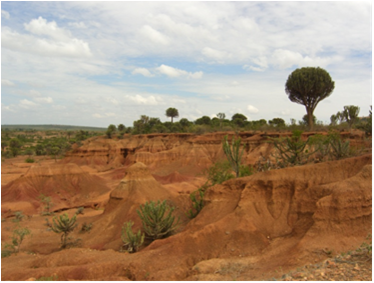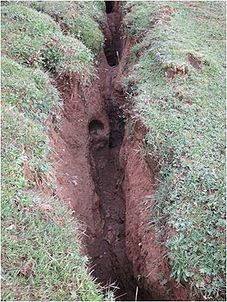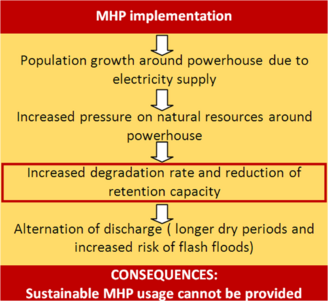Knowledge fuels change
For over a decade, Energypedia has shared free, reliable energy expertise with the world.
We’re now facing a serious funding gap.
Help keep this platform alive — your donation, big or small, truly matters!
Thank you for your support
Causes and Features of Watershed Degradation related to MHP Projects
Causes of watershed degradation
Deforestation and Destruction of Natural Vegetation
Overexploitation
Overexploitation occurs when arable land is used beyond its fertility potential without substituting the loss of nutrients by fertilizers or appropriate fallow periods[1]. Contributing to this overexploitation might be the shift from rainfed agriculture to modern agricultural methods, cash cropping and population growth. Overexploitation can lead to a variety of erosion features such as Gully erosion, landslides and alternation of discharge and should thus be prevented in order to provide sustainable use of the MHP.
Overgrazing
Overgrazing occurs when the number of livestock on a unit of land is too large. Resultant to this is the destruction of natural vegetation as well as soil compaction and erosion (cattle step). Furthermore the photosynthesis and hence biomass production and carrying capacity is decreased. Vegetation damages occur not only due to cattle bites, but also due to cattle step and pawing. Also the lack of a grazing plan which includes rotation of grazing ground, and, moreover, the lack of a national land use plan may contribute to overgrazing[2]. Like overexploitation, overgrazing can result in various degradation features such as alternation of discharge, change of soil moisture and gully erosion and thus might compromise the sustainable use of the MHP.
Unadjusted irrigation techniques
The implementation of irrigation techniques can lead to degradation, when the technical know how and/or the appropriate instruments are missing. Degradation, primarily in form of salinization, occurs in this case due to a bias between water inflow and outflow or the use of salty water[2].
Socio-economic and political causes
Various socio-economic as well as political causes can lead to land degradation. As mentioned earlier, population growth is a major cause of degradation, since it contributes to overgrazing, overexploitation and deforestation. Furthermore degradation occurs due to underdevelopment, since resources are often exploited to benefit developed countries and thus little profit is left in developing countries to manage or restore degraded areas[3]. Also rural-urban migration contributes to the occurrence of degradation, since urban populations need more firewood than rural populations. Hence the growth of urban populations in general goes hand in hand with an increase in deforestation and thus degradation.
Natural Causes
Not only human action can cause degradation to occur, but also natural causes such as the nature of rainfall (amount, intensity, variability, distribution…), soil (texture, structure, depth, moisture, infiltration rate…) and topography play an important role in the scope and scale of occurring degradation features.
|
Note: The MHP will particularly be affected by alternation of discharge and sediment load of the river. |
|
Note: |
Features of watershed degradation
Gully Erosion and Badlands
Gully erosion occurs when, during a rain event, laminar surface runoff becomes linear and strongly deepens small rills/riverbeds. The intensity of deepening depends on the slope and the ground texture/structure. Mostly gully erosion occurs where the vegetation cover is degraded and the infiltration rate is decreased. Badlands, an extreme form of gully erosion, form as full molds between wide gullies and are hardly or not arable[4].

|

|
| Badlands | Gully Erosion |
Sheet and splash erosion
Due to the decreased infiltration capacity of the soil, surface runoff and thus sheet erosion increases. The process is further intensified by splash erosion, caused by the impact of raindrops hitting the ground[5]. A typical feature of sheet erosion is the laminar lowering of the surface, which is indicated by uncovered tree roots.
The MHP will be negatively affected by the resultant increase of sediment load of the rivers.
Landslides
Landslides may occur due to a variety of natural and human causes. Geological and morphological and thus natural causes can be, for example, weak or weathered material, contrast in permeability of material or shrink-and-swell weathering. Human causes on the other hand might include deforestation, land use change, excavation of slopes or irrigation[6].
The MHP will primarily affected by the increase of sediment load in the water caused by the landslide event. In case the magnitude of an event is big enough, the river might even be locked off completely, which could decrease or even stop the water flow and thus heavily affect the MHP use.
Alternation of discharge
Alternation of discharge often shows in a decreased discharge amount or frequency. The latter often includes the occurrence of flash floods, which are short but very intense flood events. Alternation of discharge occurs due to a degradation of vegetation and the aridification of topsoil. Furthermore the process also increases soil erosion (due to floods)[2].
Alternation of discharge is the degradation feature which affects the sustainable use of the MHP the most, since without a continuous water flow, the electricity supply cannot be provided. <span id="fck_dom_range_temp_1300367155266_334" />
Changes in soil moisture and groundwater
Decrease of soil moisture and groundwater as well as a decrease of groundwater recharge are further features of degradation[7]. Due to the removal of the vegetation cover, the topsoil experiences an increase of evaporation and hence the formation of air spaces (aridification), which in turn reduces the water conductivity. This leads, on the one hand, to the creation of an evapotranspiration barrier, however, on the other hand it results in a decreasing infiltration rate and thus in increased surface runoff[2].
Changes in soil moisture and groundwater thus not only decrease the retention capacity of the soil but also increase the sediment load in the rivers which in turn negatively affects the sustainable use of the MHP.
Changes in soil texture and cattle step
Soil compaction is primarily caused by cattle step. Due to the decrease of pore volume, the infiltration rate decreases, which can, depending of the topography, lead to an accumulation of water or an increased surface runoff (and thus increased erosion potential)[8].
Just like changes in soil moisture, changes in soil texture will negatively affect the MHP use due to a decrease of retention capacity as well as an increase of sediment load.
References
- ↑ GRAINGER, A. (1990): The Threatening Desert: Controlling Desertification. London: Earthscan Publications Ltd.
- ↑ 2.0 2.1 2.2 2.3 MENSCHING, H. G. (1990): Desertifikation: Ein weltweites Problem der ökologischen Verwüstung in den Trockengebieten der Erde. Darmstadt: Wissenschaftliche Buchgesellschaft.
- ↑ THOMAS, D. S.G./ MIDDLETON, N. J. (1994): Desertification. Exploding the Myth. Chichester, New York, Brisbane, Toronto, Singapore: John Wiley &amp;amp;amp;amp;amp;amp;amp;amp;amp;amp;amp; Sons.
- ↑ LESER, H. (Hrsg.) (2005): Diercke Wörterbuch Allgemeine Geographie. Braunschweig: Westermann.
- ↑ MENSCHING, H. G./ SEUFFERT, O. (2001): (Landschafts-) Degradation – Desertifikation: Erscheinungsformen, Entwicklung und Bekämpfung eines globalen Umweltsyndroms. In: Petermanns Geographische Mitteilungen, 145 (4), 6 – 15.
- ↑ USGS (2004): Fact Sheet: Landslide Types and Processes.
- ↑ BAUMHAUER, R. (2007): Desertifikation und Klimawandel. In: GEBHARDT, H. et al. (Hrsg. u. a. ) (2007): Geographie: Physische Geographie und Humangeographie. München, Heidelberg: Elsevier, Spektrum. S. 983 – 987.
- ↑ BALDENHOFER, K. (2002): Bodenverdichtung. In: BRUNOTTE, E. et al. (Hrsg. u. a.)(2002): Lexikon der Geographie. Heidelberg, Berlin: Spektrum.





















